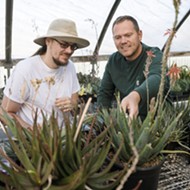SLO Beaver Brigade celebrates the semiaquatic rodent's contributions to local ecosystems on Feb. 10 in Atascadero
By Samantha Herrera[{
"name": "Ad - Medium Rectangle CC01 - 300x250",
"id": "AdMediumRectangleCC01300x250",
"class": "inlineCenter",
"insertPoint": "8",
"component": "2963441",
"requiredCountToDisplay": "12"
},{
"name": "Ad - Medium Rectangle LC01 - 300x250",
"id": "AdMediumRectangleCC01300x250",
"class": "inlineCenter",
"insertPoint": "18",
"component": "2963441",
"requiredCountToDisplay": "22"
},{
"name": "Ad - Medium Rectangle LC09 - 300x250",
"id": "AdMediumRectangleLC09300x250",
"class": "inlineCenter",
"insertPoint": "28",
"component": "3252660",
"requiredCountToDisplay": "32"
}]
Starting Feb. 10, beavers will have more eyes on them as the SLO Beaver Brigade and the Atascadero City Council team up to celebrate their contributions to California's ecosystem.
Beginning at 9 a.m. at the De Anza Trailhead in front of the Atascadero wastewater treatment facility, the Central Coast organization will unveil a new interpretive panel.
SLO Beaver Brigade Executive Director Audrey Taub told New Times that two new interpretive panels and kiosks along the Juan Bautista De Anza Trail will display information on beaver habits.
"One panel will focus on the habitat that beavers create. They build dams and they create wetlands that store a lot of water on the landscape and create very biodiverse habitats," she said. "Lots of birds, frogs, and turtles find their homes there. The other panel focuses on fire and groundwater storage and how beaver dams are known to store 10 times more water in the ground than on the surface."
Taub said these wetlands are a refuge for the local animals and serve as firebreaks for cities and towns along the Salinas River.
To help fund these new interpretive panels, Taub said SLO Beaver Brigade received a Whale Tail Grant of a little more than $40,000 from the California Coastal Commission.
"This will pay for the panels, a mural we have coming to the Charles Paddock Zoo that we will unveil on Earth Day, and educational tours," she said. "We offer two a month to the community for free, and we offer those in Spanish and are wheelchair accessible as well."
Field trips are also offered for a variety of local schools, and Taub said so far schools in Oceano and Atascadero are on the calendar.
Coming out and hearing about beavers is a great way to learn about California's natural ecosystems, Taub said.
"Beavers are rodents, and they eat woody materials, tree bark, and herbaceous plants," she said. "Beavers create habitat for fish, and there's been this long saying that beavers actually taught salmon to jump because they had to learn to jump over beaver dams and make their way into the ocean."
Taub said that on the Central Coast, beavers and steelhead trout have evolved together for many years because steelhead trout can safely mature behind a beaver pond and swim out to the ocean in spring to continue their life cycle.
"I come across some old-timers in the area, and they talk about how they used to catch 26-inch steelheads in the Atascadero Creek and the Salinas River and it's really from a breakdown of all these hydraulic functions that beavers provide," she said. "They build a dam that slows down the water and gives it time to sink into the groundwater. Oftentimes in North County, the Salinas River will run dry on the surface and continue flowing under[ground] except where the beavers are."
Over the past three years, researchers studying beavers in the Salinas River found that in periods of drought, beaver habitat maintained wetness and actually got greener, showing zero signs of drought, Taub said.
However, acknowledging the benefits beavers give to California's ecosystem is a new movement, Taub said. Prior to last year, when Gov. Gavin Newsom announced the beaver restoration project, it was legal to exterminate beavers.
Phase one of the beaver restoration project reintroduced a family of beavers into the wild on ancestral lands of the Mountain Maidu people in Plumas County. That was the first time beavers have been reintroduced in the wild in 75 years, according to a Dec. 13, 2023, press release from Newsom's office.
Since the spotlight on beavers is new, Peter Tira from California Fish and Wildlife told New Times that the state doesn't have beaver stats.
"We actually don't have population numbers for beavers or most other species in California," he said. "But beavers are very prolific and very widespread throughout the state. They're healthy and overall doing a great job."
Now the state will be using beavers to help restore rivers, Taub said. From the most northern part of the state to the most southern, beavers will be released into the wild to help create healthy ecosystems.
"Beavers mate for life and they have one litter every year. The young usually stay with their parents for around three years and the family is very communal, they all work together," she said. "So, to have a successful relocation and river restoration, they need to capture and release the whole family."
Fast fact
• The Oceano Seabreeze Market is coming to the Oceano Depot on Feb. 11 from noon to 5 p.m. The market will host a variety of booths, such as homemade chocolates from Momobean Chocolates and jewelry from Imagination. Admission is free, and parking will be available at the Oceano Community Services District. Δ
Reach Staff Writer Samantha Herrera at [email protected].










